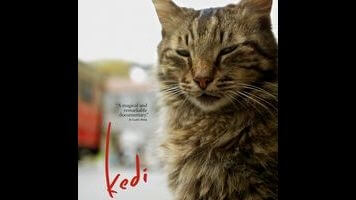At one point in Kedi, a documentary portrait of Istanbul’s many stray cats, one of the interview subjects explains why she regularly opens her door to a particular feline who comes a-callin’. This woman lives on the second floor of her building, close enough to the ground for cats to reach her balcony via nearby trees. Many curious kitties show up, but they don’t generally gain entrance, because the woman has a cat of her own and wants to avoid territorial disputes. She’s helpless, however, to refuse a neighborhood cat named Gamsiz. Why? Because all of the other cats (including her own) face the balcony’s glass door when they want in, taking a confrontational stance. They’re direct. Gamsiz, by contrast, sits sideways by the door, looking over one “shoulder,” with one paw slightly raised in the air. The woman describes this pose in detail, and then director Ceyda Torun shows it in action… and it’s freakin’ adorable. Gamsiz looks oddly dignified, as if he should be wearing a top hat and a monocle. “I say, I don’t mean to intrude, but…”
It’s anecdotes like these that make Kedi more than just a very professionally shot series of cute cat videos on YouTube. After all, there’s not much need for a documentary about animals that we all know pretty well already. Istanbul’s cat population happens to be predominantly stray, but the seven cats profiled here aren’t exactly feral—all of them have been given names by the locals who feed and pet them (none is named Kedi, which is presumably the Turkish equivalent of “kitty”), and more or less qualify as pets with unlimited freedom of movement. They have distinct personalities, but, you know, they’re cats. Even the one known as Psikopat (or “psycho” in Turkish) exhibits standard-issue cat behavior. Inevitably, the film doubles as an intimate exploration of one of the world’s most beautiful cities, with a fun “Where’s Waldo?” element; Torun includes numerous aerial shots, and it’s impossible not to scour the frame looking for the cat that’s usually just barely visible somewhere. Were Kedi strictly about Istanbul and cats, though, it’d be pretty banal.
Instead, there’s a fascinating therapeutic undercurrent to the interviews with human beings. Torun doesn’t intellectualize this in any way; no experts show up to discuss our tendency to anthropomorphize animals, seeing ourselves in them. But several people talk frankly about having felt broken in some way, and about how taking care of homeless cats feels redemptive. One middle-aged shopkeeper has such a reputation as the area’s designated feline helper that he actually gets interrupted in the middle of a personal anecdote by someone who hands him a badly injured kitten, barely clinging to life; the camera follows him as he hurries to the vet, cupping the kitten’s limp body in his palms, but we never learn what happens. That’s not the point. Kedi doesn’t emphasize this element as much as it might have—a sizable chunk of the film resembles cat videos one can find all over the place (apart from having been shot with better equipment). When it uses cats as a stealthy means to investigate the human heart, however, it unsheathes its claws.


 Keep scrolling for more great stories from The A.V. Club.
Keep scrolling for more great stories from The A.V. Club.